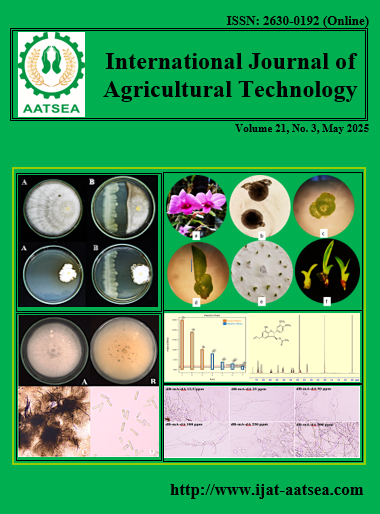Employing in-situ hydrogen peroxide generation to alleviate aquatic impact from methylene blue-contaminated water
Main Article Content
Abstract
The accumulation of dyes in aquatic environments poses significant ecological risks, and methylene blue (MB) is one such dye that requires effective removal. This study evaluated the efficiency of an electrolytic system for generating hydrogen peroxide (H₂O₂) to decolorize MB. The process was optimized by examining the effects of pH, applied current, and activated carbon (AC) weight using Response Surface Methodology (RSM). Results indicated a high coefficient of determination (R² = 0.9446), demonstrating the robustness of the predictive model for decolorization. Increasing applied current, oxidation time, and AC weight improved color removal, while lower pH levels enhanced the process, consistent with electro-Fenton principles. The maximum color removal achieved was 57.51% under optimal conditions. Additionally, three hydrogen peroxide production methods—bubbling, electrolysis, and electrolysis with Fe²⁺ addition—were compared. The results showed that while bubbling alone was less effective for color removal, both electrolysis and electrolysis with Fe²⁺ significantly increased color removal, with electrolysis and Fe²⁺ addition proving to be the most effective method. This study highlights the potential of an electrolytic system for efficient dye decolorization, offering a promising solution for treating dye-contaminated water.
Article Details

This work is licensed under a Creative Commons Attribution-NonCommercial-NoDerivatives 4.0 International License.
References
Arazo, R. O., Abonitalla, M. R., Michael, J., Gomez, O., Quimada, N. E., Michael, K., Yamuta, D., Mugot, D. A., Muhammad, P. and Hanif, U. (2016). Biodiesel Production from Swietenia macrophylla (Mahogany) Seeds. Journal of Higher Education Research Disciplines, 1:8-8.
Bañuelos, J. A., El-Ghenymy, A., Rodríguez, F. J., Manríquez, J., Bustos, E., Rodríguez, A., Brillas, E. and Godínez, L. A. (2014). Study of an air diffusion activated carbon packed electrode for an electro-fenton wastewater treatment. Electrochimica Acta, 140:412-418.
Colades, J. I., De Luna, M. D. G., Su, C. C. and Lu, M. C. (2015). Treatment of thin film transistor-liquid crystal display (TFT-LCD) wastewater by the electro-Fenton process. Separation and Purification Technology, 145:104-112.
Fayazi, M., Taher, M. A., Afzali, D. and Mostafavi, A. (2016). Enhanced Fenton-like degradation of methylene blue by magnetically activated carbon/hydrogen peroxide with hydroxylamine as Fenton enhancer. Journal of Molecular Liquids, 216:781-787.
Georgi, A. and Kopinke, F. D. (2005). Interaction of adsorption and catalytic reactions in water decontamination processes: Part I. Oxidation of organic contaminants with hydrogen peroxide catalyzed by activated carbon. Applied Catalysis B: Environmental, 58:9-18.
Hidayu, A. R. and Muda, N. (2016). Preparation and characterization of impregnated activated carbon from palm kernel shell and coconut shell for CO2 capture. Procedia Engineering, 148:106-113.
Javed, M. S., Rehman, M., Miah, N., Melon, M. H., Hossain, A. and Quimada, N. E. (2024). The importance of green leadership and green communication allies in the potential to promote a sustainable practice and reduced a negative impact on human activities on environment in management. Migration Letters, 21:74-93.
Khataee, A. R., Safarpour, M., Zarei, M. and Aber, S. (2011). Electrochemical generation of H2O2 using immobilized carbon nanotubes on graphite electrode fed with air: Investigation of operational parameters. Journal of Electroanalytical Chemistry, 659:63-68.
Mehra, S., Singh, M. and Chadha, P. (2021). Adverse impact of textile dyes on the aquatic environment as well as on human beings. Toxicology International, Informatics Publishing Limited, 28:165-176. https://doi.org/10.18311/ti/2021/v28i2/26798
Mohd Iqbaldin, M., Khudzir, I., Mohd Azlan, M., Zaidi, A., Surani, B. and Zubri, Z. (2013). Properties of coconut shell activated carbon. Journal of Tropical Forest Science, 25:497-503.
Nurbazilah, S., Jabal, A. and Hoon, F. (2016). The Potential of Coconut Shell Powder (Csp) and Coconut Shell Activated Carbon (Csac) Composites as Electromagnetic Interference (Emi) Absorbing Material (Potensi Serbuk Tempurung Kelapa (CSP) dan Karbon Teraktif Tempurung Kelapa (CSAC) Sebagai Bahan Penyerap Gangguan Elektromagnatik). Malaysian Journal of Analytical Sciences, 20:444-451.
Oladoye, P. O., Ajiboye, T. O., Omotola, E. O. and Oyewola, O. J. (2022). Methylene blue dye: Toxicity and potential elimination technology from wastewater. In Results in Engineering, 16:1-17 Elsevier B.V. https://doi.org/10.1016/j.rineng.2022.100678
Quimada, N., Comia, J. J., Beak, S., Rhay Bayantong, A. and Villaroya Logronio, F. (2024). Efficiency of combined electrocoagulation using aluminum electrodes and mahogany pods activated carbon in the removal of cod and decolorization of dye-contaminated wastewater. Science International, 36:71-75.
Quimada, N. E., De Luna, M. D. G. and Lu, M. C. (2020). Treatment of printed circuit board wastewater containing copper and nickel ions by fluidized-bed homogeneous granulation process. Advances in Science, Technology and Innovation, Springer Nature, pp.191-193. https://doi.org/10.1007/978-3-030-13068-8_47
Quimada, N. E., Sioson, A. S., Sutopo, F. and Mabayo, V. I. F. (2023). Response surface optimization of the efficiency of ZnCl2-impregnated activated carbon from residual coffee grounds in the removal of Eriochrome Black T dye-contaminated wastewater. Biomass Conversion and Biorefinery, 14:7555-7567.
John Wiley & Sons, Inc.


